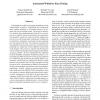Free Online Productivity Tools
i2Speak
i2Symbol
i2OCR
iTex2Img
iWeb2Print
iWeb2Shot
i2Type
iPdf2Split
iPdf2Merge
i2Bopomofo
i2Arabic
i2Style
i2Image
i2PDF
iLatex2Rtf
Sci2ools
118
Voted
NDSS
2008
IEEE
2008
IEEE
Automated Whitebox Fuzz Testing
Fuzz testing is an effective technique for finding security vulnerabilities in software. Traditionally, fuzz testing tools apply random mutations to well-formed inputs of a program and test the resulting values. We present an alternative whitebox fuzz testing approach inspired by recent advances in symbolic execution and dynamic test generation. Our approach records an actual run of the program under test on a well-formed input, symbolically evaluates the recorded trace, and gathers constraints on inputs capturing how the program uses these. The collected constraints are then negated one by one and solved with a constraint solver, producing new inputs that exercise different control paths in the program. This process is repeated with the help of a code-coverage maximizing heuristic designed to find defects as fast as possible. We have implemented this algorithm in SAGE (Scalable, Automated, Guided Execution), a new tool employing x86 instruction-level tracing and emulation for white...
Related Content
| Added | 01 Jun 2010 |
| Updated | 01 Jun 2010 |
| Type | Conference |
| Year | 2008 |
| Where | NDSS |
| Authors | Patrice Godefroid, Michael Y. Levin, David A. Molnar |
Comments (0)

